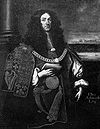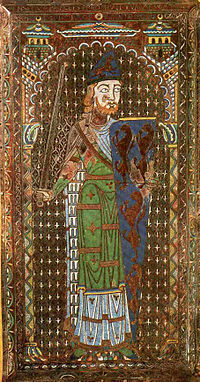Portal:Heraldry
Welcome to the Heraldry and Vexillology Portal!


Heraldry encompasses all of the duties of a herald, including the science and art of designing, displaying, describing and recording coats of arms and badges, as well as the formal ceremonies and laws that regulate the use and inheritance of arms. The origins of heraldry lie in the medieval need to distinguish participants in battles or jousts, whose faces were hidden by steel helmets.
Vexillology (from the Latin vexillum, a flag or banner) is the scholarly study of flags, including the creation and development of a body of knowledge about flags of all types, their forms and functions, and of scientific theories and principles based on that knowledge. Flags were originally used to assist military coordination on the battlefield, and have evolved into a general tool for signalling and identification, particularly identification of countries.
Selected article

The Shield of the Trinity or Scutum Fidei is a traditional Christian visual symbol which expresses many aspects of the doctrine of the Trinity, summarizing the first part of the Athanasian Creed in a compact diagram. In medieval England and France, this emblem was considered to be the heraldic arms of God (and of the Trinity). The precise origin of this diagram is unknown, but it was evidently influenced by 12th-century experiments in symbolizing the Trinity in abstract visual form, mainly by Petrus Alfonsi's Tetragrammaton-Trinity diagram of ca. 1109.
The Shield of the Trinity diagram is attested from as early as a ca. 1208-1216 manuscript. The diagram was used heraldically from the mid-13th century, when a shield-shaped version of the diagram (not actually placed on a shield) was included among the heraldic shields in Matthew Paris' Chronica Majora, ca. 1250. Allegorical illustrations ca. 1260 show the diagram placed on a shield. The period of its most widespread use was during the 15th and 16th centuries, when it is in found in a number of English and French manuscripts, books, stained-glass windows and ornamental carvings. (more...)
Selected biography

Elias Ashmole was an antiquarian, collector, politician and officer of arms. He supported the royalist side during the English Civil War, and at the restoration of Charles II he was rewarded with several lucrative offices, including Windsor Herald of Arms in Ordinary. Throughout his life he was an avid collector of curiosities and other artifacts. Many of these he acquired from the traveller, botanist, and collector John Tradescant the elder and his son of the same name, and most he donated to Oxford University to create the Ashmolean Museum. He also donated his library and priceless manuscript collection to Oxford. Apart from his collecting activities, Ashmole illustrates the passing of the pre-scientific world view in the seventeenth century: while he immersed himself in alchemical, magical and astrological studies and was consulted on astrological questions by Charles II and his court, these studies were essentially backward-looking. Although he was one of the founding members of the Royal Society, a key institution in the development of experimental science, he never participated actively. (more...)
Selected flag

The flag of Australia was chosen in 1901 from entries in a worldwide design competition held following Federation. It was approved by Australian and British authorities over the next few years, although the exact specifications of the flag were changed several times both intentionally and as a result of confusion. The current specifications were published in 1934, and in 1954 the flag became legally recognised as the "Australian National Flag". The flag is a defaced Blue Ensign: a blue field with the Union Flag in the canton (upper hoist quarter), and a large white seven-pointed star known as the Commonwealth Star in the lower hoist quarter. The fly contains a representation of the Southern Cross constellation, made up of five white stars – one small five-pointed star and four, larger, seven-pointed stars. (more...)
Selected picture

The tomb of Geoffrey V, Count of Anjou is one of the first recorded examples of hereditary armory in Europe.
Did you know...
- ...that during World War II the records of the College of Arms were stored in Thornbury Castle (pictured), home of Sir Algar Howard, Norroy and Ulster King of Arms?
- ...that Henry Lane was appointed Bluemantle Pursuivant at the age of 15?
- ...that the Seal of Oregon includes a British man-of-war departing and an American steamer arriving?
- ...that after the 1989 fall of the Berlin Wall, many East Germans cut the central coat of arms from the East German flag, and the Foundation for the Reconciliation of the SED Dictatorship still uses this as its logo?
- ...that a romantic scene in Sir Walter Scott's Ivanhoe refers to an area near Smisby in Derbyshire which was thought to have been used for ancient jousting battles?
Related portals
|
|
|
Heraldry Web resources
Authorities
- Belgium - The Council of Nobility, Flemish Heraldic Council and Council of Heraldry and Vexillology of the French Community
- Canada - Canadian Heraldic Authority and see also Public Register of Arms, Flags and Badges
- England, Wales, and Northern Ireland - The College of Arms
- Ireland - The Office of the Chief Herald of Ireland
- Netherlands - High Council of Nobility
- Portugal - Instituto da Nobreza Portuguesa
- Scotland - The Court of the Lord Lyon
- South Africa - South African Bureau of Heraldry
- Sweden - National Board of Heraldry, The National Archive
- United States Army - The United States Army Institute of Heraldry
Societies
- Greek Heraldry Society
- The Academy of Heraldic Science Czech republic
- The American College of Heraldry
- The American Heraldry Society
- The Augustan Society
- The Australian Heraldry Society Inc.
- Bulgarian Heraldry and Vexillology Society
- The Center for Research of Orthodox Monarchism
- Cambridge University Heraldic and Genealogical Society
- Chiltern Heraldry Group
- The College of Dracology
- Croatian Heraldic and Vexillologic Association
- The Finnish Heraldic Society
- Fryske Rie foar Heraldyk
- Hellenic Armigers Society
- Guild of Heraldic Artists
- Genealogical Society of Ireland
- Heraldry Research Institute (Japan)
- The Heraldry Society
- The Heraldry Society of Africa
- The Heraldry Society of New Zealand Inc.
- The Heraldry Society of Scotland
- The Heraldry Society of Southern Africa
- The Institute of Heraldic and Genealogical Studies
- The International Association of Amateur Heralds
- Italian Center of Vexillological Studies
- Lancashire Heraldry Group
- Macedonian Heraldry Society
- New England Historic Genealogical Society Committee on Heraldry
- Norwegian Heraldry Society
- Oxford University Heraldry Society
- Polish Heraldry Society
- Polish Nobility Confederation
- Real Academia Matritense de Heráldica y Genealogía - Royal Academy of Heraldry and Genealogy of Madrid
- Romanian Institute for Genealogy and Heraldry
- The Royal Heraldry Society of Canada
- The Russian College of HeraldryThe Russian College of Heraldry
- Serbian Heraldic Society
- Societas Heraldica Scandinavica
- Societas Heraldica Slovenica
- Swedish Heraldic Society
- Ukrainian Heraldry Society
- Royal Association Genealogical and Heraldic Office of Belgium
Vexillology
Software
- Coat of Arms Visual Designer web-based program
- Puncher Heraldry Program
- Blazonry Server - pyBlazon
- DrawShield - creates SVG shield or arms image from blazon
- CoaMaker - web-based tool
- Blazon95 and BLAZONS! 2000, older Windows applications
Texts
- Heraldry, historical and popular : with seven hundred illustrations (1863)
- A Complete Guide to Heraldry (1909)
Other
Wikimedia
The following Wikimedia Foundation sister projects provide more on this subject:
-
Commons
Free media repository -
Wikibooks
Free textbooks and manuals -
Wikidata
Free knowledge base -
Wikinews
Free-content news -
Wikiquote
Collection of quotations -
Wikisource
Free-content library -
Wikispecies
Directory of species -
Wikiversity
Free learning tools -
Wikivoyage
Free travel guide -
Wiktionary
Dictionary and thesaurus












